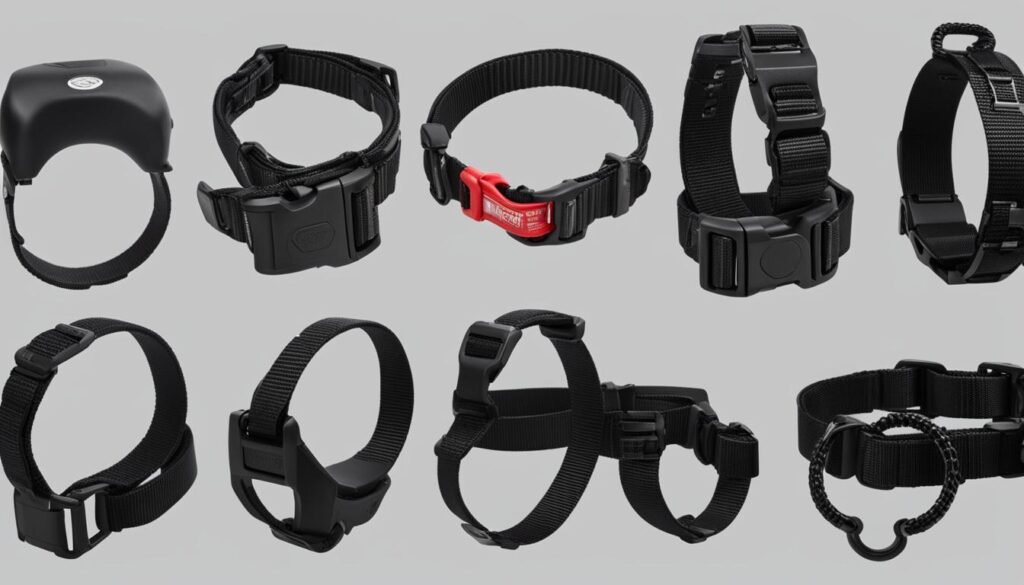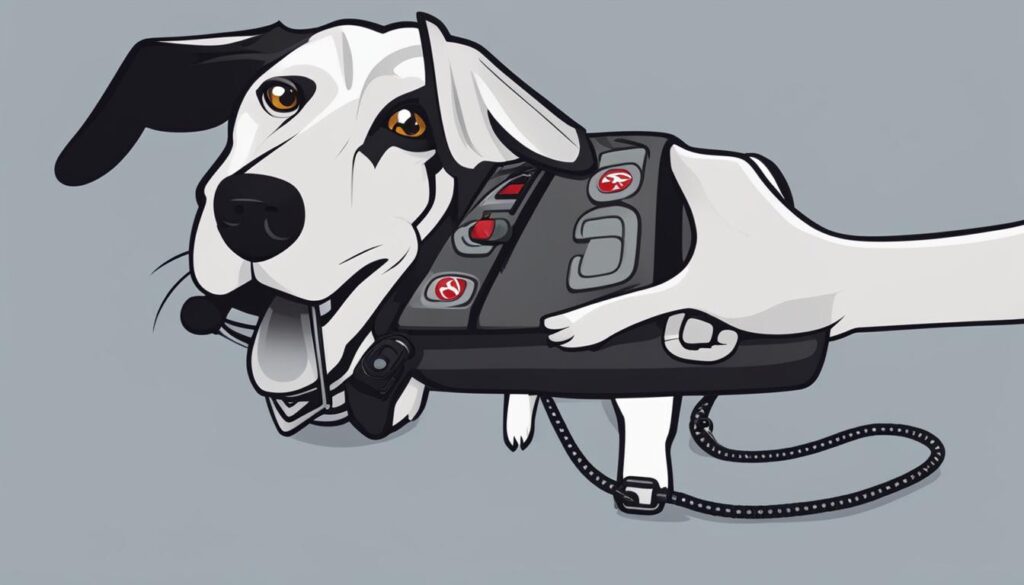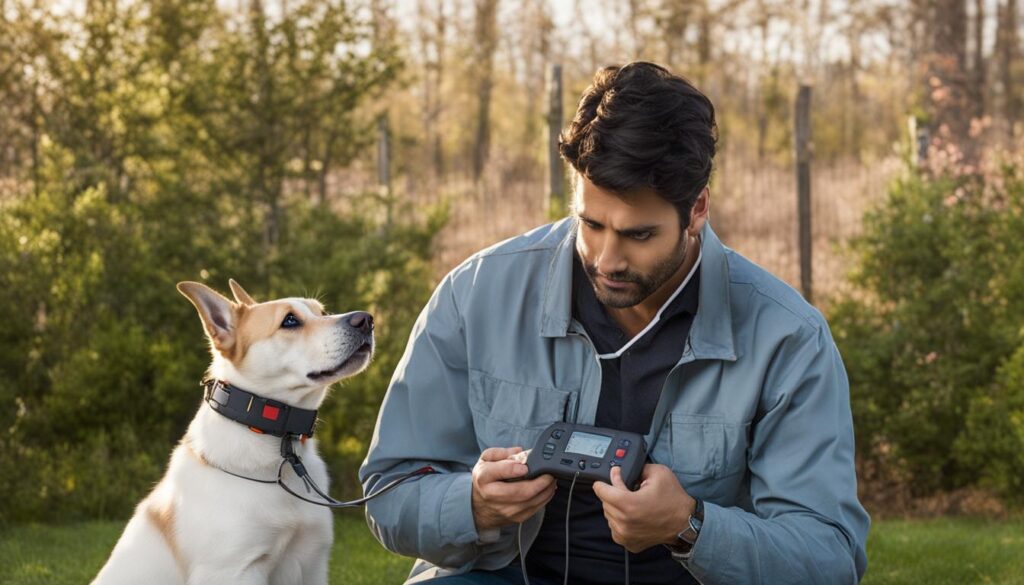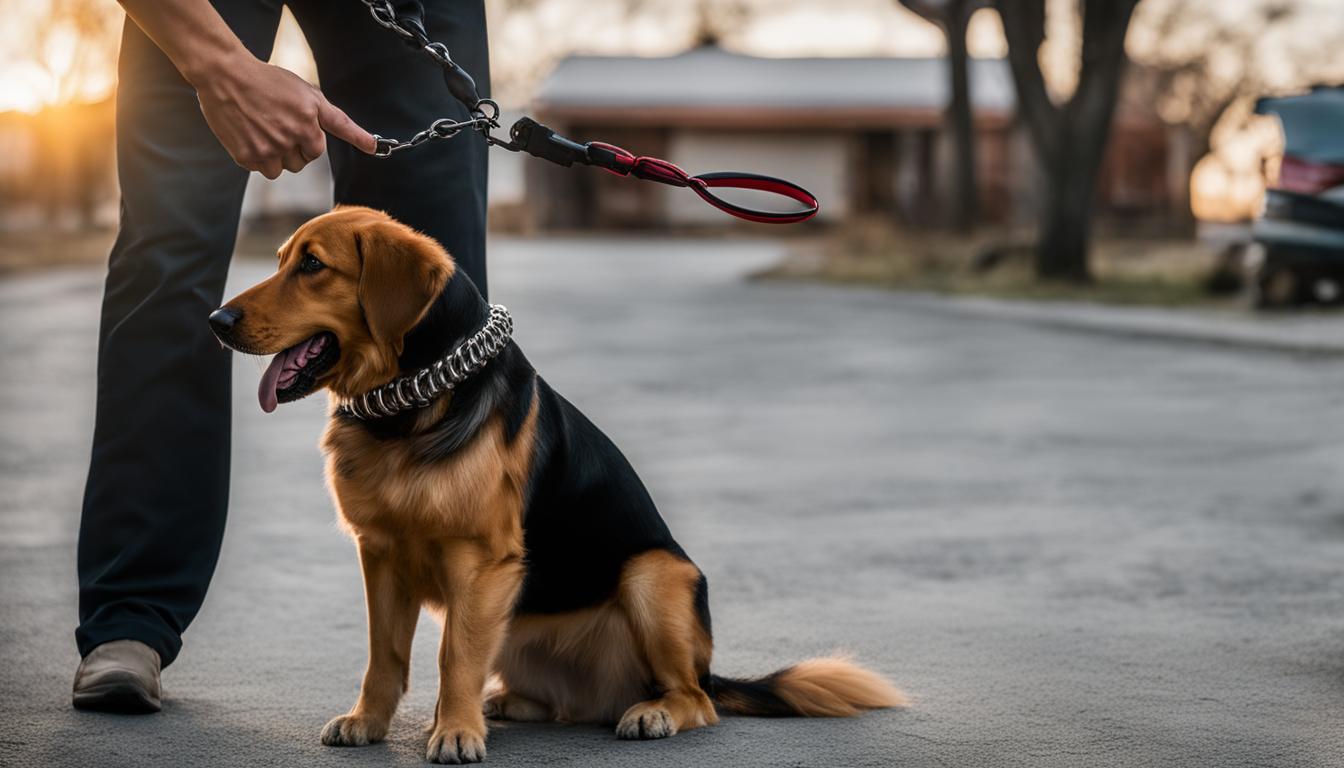Biting behavior in dogs can be a challenging issue to address. Whether it's nipping during play or aggressive biting, finding an effective solution is essential for the well-being of both your dog and those around them. One method that can be employed to tackle biting is using a shock collar.
In this guide, I will explain how to use a shock collar for biting and provide you with the necessary steps to implement this training technique effectively. As with any training method, it's crucial to approach it with care, understanding, and patience.
Key Takeaways:
- Using a shock collar can be an effective tool for addressing biting issues in dogs.
- Proper techniques and considerations are essential for successful shock collar training.
- Take the time to understand the principles behind shock collar training for biting behavior correction.
- Before starting the training, assess your dog's temperament and behavior to ensure suitability.
- Consulting with a professional trainer and choosing the right shock collar are crucial pre-training considerations.
Understanding the Basics of Shock Collar Training for Biting
Before delving into the specific steps of using a shock collar for biting, it's essential to grasp the fundamentals of shock collar training. By understanding the principles behind this training method, you can effectively address biting behavior in dogs.
Shock collar training for biting involves the use of a collar that delivers a mild electric stimulation to the dog when they exhibit biting behavior. This correction helps the dog associate biting with an unpleasant sensation, encouraging them to avoid biting in the future.
It's important to note that shock collar training should always be conducted under the guidance of a professional dog trainer who has experience in using these devices responsibly and humanely. They can help you determine if a shock collar is appropriate for your dog's specific needs and provide valuable guidance throughout the training process.
“When used properly and in conjunction with positive reinforcement techniques, shock collar training can be an effective tool for correcting biting behavior in dogs.” – Professional Dog Trainer
During shock collar training for biting, the collar is typically worn around the dog's neck and controlled remotely by the trainer. The stimulation level can be adjusted to suit the individual dog, ensuring it is neither too mild nor too severe.
It's important to remember that shock collar training should not be used as a standalone solution for biting behavior. It should be incorporated into a comprehensive training program that includes foundational obedience training, positive reinforcement techniques, and consistent guidance from a professional trainer.
Biting behavior correction with a shock collar can be effective when used responsibly and in conjunction with other training methods. By understanding the basics of shock collar training, you can work towards addressing your dog's biting behavior and fostering a safe and harmonious environment for both you and your furry companion.
Pre-Training Considerations for Using a Shock Collar for Biting
Before starting shock collar training for biting, it's important to take several pre-training considerations into account. These steps will help ensure the effectiveness and safety of using a shock collar as a tool to address biting behavior in dogs. Here are the key factors to keep in mind:
Assessing Your Dog's Temperament and Behavior
Assessing your dog's temperament and behavior is crucial before beginning shock collar training for biting. Every dog is unique and may respond differently to training methods. Take the time to observe and understand your dog's natural tendencies, triggers, and any underlying issues that may contribute to the biting behavior. This assessment will help you tailor the training approach to suit your dog's needs and temperament.
Consulting with a Professional Trainer
Consulting with a professional trainer is highly recommended when considering the use of a shock collar for biting. A qualified trainer will have the expertise and experience to guide you through the process, ensuring proper techniques and humane training practices. They can provide valuable insights, personalized advice, and help address any specific challenges or concerns you may have. Trainers can also help assess whether a shock collar is the most suitable option for your dog's biting behavior.
Choosing the Right Shock Collar
Choosing the right shock collar for biting is essential to the success of your training efforts. There are various models and features available in the market, so it's important to select one that is safe, effective, and suitable for your dog's size, breed, and temperament. Look for shock collars with adjustable intensity levels, multiple training modes, and reliable safety features. It's also crucial to purchase the shock collar from reputable brands or manufacturers known for their commitment to quality and animal welfare.


| Factors to Consider When Choosing a Shock Collar | Importance |
|---|---|
| Size and Weight | Different shock collars are designed for specific sizes and weights of dogs, ensuring an appropriate fit and maximum comfort. |
| Stimulation Levels | Look for shock collars with adjustable stimulation levels to provide the right amount of correction for your dog's biting behavior. |
| Training Modes | Consider shock collars with multiple training modes, such as vibration or beep, to provide alternative and gentler forms of correction. |
| Safety Features | Ensure the shock collar has safety features like automatic shut-off, protection against accidental triggering, and waterproof construction. |
Choosing the right shock collar for biting is a critical step in the training process. By considering factors like size, stimulation levels, training modes, and safety features, you can ensure a positive and effective training experience for both you and your dog.
Foundational Obedience Training Before Shock Collar Introduction
Before introducing a shock collar for biting, it's crucial to establish a foundation of obedience training. Building a strong obedience foundation is essential to ensure effective communication and cooperation between you and your dog.
Foundational obedience training provides your dog with the necessary behavioral framework and sets the stage for successful shock collar training for biting. It establishes a positive and respectful relationship, promotes discipline, and enhances responsiveness to commands. This training also helps to develop your dog's impulse control, focus, and overall behavior.
To begin with foundational obedience training, it's important to focus on teaching your dog basic commands such as sit, stay, come, and leave it. These commands create a solid starting point and establish your role as the leader and authority figure in your dog's life.
Remember to be patient and consistent throughout the training process, using positive reinforcement techniques such as treats, praise, and rewards to encourage desired behavior. Avoid using punishment or force, as it can undermine the trust and confidence your dog has in you as their trainer.
Incorporating regular training sessions into your daily routine will help reinforce the obedience training and improve your dog's overall behavior and responsiveness. Consistency is key, so aim to provide frequent and structured training sessions that are easy for your dog to understand and follow.
By laying a strong foundation of obedience training before introducing a shock collar for biting, you are setting your dog up for success. The combination of foundational obedience training and the proper use of a shock collar can effectively address biting behavior in dogs while promoting a healthy and harmonious relationship between you and your furry companion.
How to Use a Shock Collar for Biting: A Step-by-Step Guide
Biting behavior can be a challenging issue to address in dogs, but with the proper guidance and techniques, a shock collar can be an effective tool to curb this behavior. In this section, I will provide you with a step-by-step guide on how to use a shock collar for biting, ensuring the safety and well-being of your furry friend.
Introducing the Shock Collar to Your Dog
Before using a shock collar for biting, it's important to introduce it to your dog in a positive and gradual manner. Follow these steps:
- Start by allowing your dog to sniff and explore the shock collar while it is turned off.
- Once comfortable, gently fasten the shock collar around your dog's neck, ensuring it is snug but not too tight.
- Give your dog a treat or praise to create a positive association with the collar.
- Allow your dog to wear the collar for short periods, gradually increasing the duration over time.
- Monitor your dog's behavior and comfort level during the introduction process, making adjustments as needed.
Finding the Appropriate Stimulation Level
One of the most crucial aspects of using a shock collar for biting is finding the appropriate stimulation level that effectively communicates the desired message without causing harm or distress to your dog. Follow these steps:
- Start with the lowest stimulation level.
- Observe your dog's response to the shock collar, paying attention to changes in behavior or signs of stress.
- If the lowest stimulation level is ineffective, gradually increase the intensity until you observe a noticeable response without causing discomfort.
- Remember, every dog is different, so it's essential to find the stimulation level that works best for your pet.
Employing the Tapping Method to Redirect Focus
Redirecting your dog's focus away from biting behavior is a key aspect of using a shock collar effectively. The tapping method can help redirect their attention. Here's how:
- When you notice your dog displaying biting behavior, gently tap the remote button to activate a mild shock.
- Immediately after shocking, redirect your dog's attention by offering a distraction such as a toy or treat.
- Repeat this process consistently whenever your dog engages in biting behavior.
- Over time, your dog will associate the tapping sensation with the redirection and learn to disengage from biting on command.


Incorporating a Shock Collar for Biting Control
Once the shock collar has been introduced, it's essential to incorporate it into a comprehensive biting control training program. By implementing specific techniques, you can redirect your dog's attention away from biting triggers, maintain a calm and consistent training approach, and use commands to manage behavior in the presence of distractions.
Redirecting Attention Away from Biting Triggers
To effectively control biting behavior, it's important to redirect your dog's attention away from stimuli that trigger biting. This can be achieved by:
- Identifying potential biting triggers and avoiding or minimizing exposure to them.
- Using positive reinforcement techniques, such as treats or toys, to redirect your dog's focus onto more appropriate behaviors.
- Engaging your dog in interactive play or training exercises to provide mental and physical stimulation, reducing the likelihood of biting.
Maintaining a Calm and Consistent Training Approach
Dogs respond best to training that is conducted in a calm and consistent manner. To effectively incorporate a shock collar for biting control, follow these guidelines:
- Remain calm and composed during training sessions to create a positive and relaxed environment for your dog.
- Consistently enforce the rules and boundaries established during training, ensuring that your dog understands what is expected of them.
- Avoid becoming frustrated or agitated during training, as this can negatively impact your dog's progress and behavior.
Using Commands to Manage Behavior in the Presence of Distractions
Distractions can pose a challenge when training a dog to control biting behavior. To manage behavior effectively, incorporate the use of commands:
- Teach your dog commands such as “sit,” “stay,” and “leave it” to redirect their attention and prevent them from engaging in biting behavior.
- Practice these commands in an environment with increasing levels of distractions, gradually helping your dog to maintain focus and obedience even in challenging situations.
- Reward your dog with praise, treats, or play when they respond appropriately to commands, reinforcing positive behavior and strengthening their training.
By incorporating these techniques into your biting control training program, you can effectively use a shock collar to redirect your dog's attention, maintain a calm training approach, and manage behavior in various environments and circumstances.


Preventing Biting Behavior with a Shock Collar
In addition to addressing and correcting existing biting behavior, a shock collar can also be used to prevent future biting incidents. By utilizing a shock collar as a preventative measure, pet owners can promote overall good behavior in their dogs and create a safe and harmonious environment.
When using a shock collar for preventative purposes, it is important to establish clear boundaries and reinforce positive behaviors. Through consistent training and reinforcement, dogs can learn to associate biting behavior with negative consequences and develop alternative ways to express themselves.
To effectively prevent biting behavior with a shock collar, consider the following strategies:
- Early Intervention: Start using the shock collar at the first signs of aggression or nipping to nip the problem in the bud.
- Positive Reinforcement: Combine the use of the shock collar with positive reinforcement techniques to reward and encourage desired behaviors.
- Consistency: Be consistent in enforcing boundaries and follow through with consequences whenever biting behavior occurs.
By incorporating these strategies, pet owners can effectively prevent biting behavior and ensure the safety of both their dogs and those around them.
Safety Precautions When Using Shock Collars for Biting
Safety is of utmost importance when using shock collars for biting training. By following proper safety precautions, you can ensure a safe and effective training experience for both you and your dog. In this section, I will highlight the key safety considerations to keep in mind when using a shock collar for biting.
Understanding the Implications of Incorrect Usage
Incorrect usage of shock collars can have negative consequences for your dog's well-being and the effectiveness of the training. It is crucial to understand the implications of incorrect usage to avoid potential harm. Always consult the manufacturer's instructions and seek guidance from a professional dog trainer if needed. Properly using the shock collar in accordance with the recommended guidelines is essential for your dog's safety and training progress.
Recognizing Signs of Stress in Your Dog
Dogs communicate through their body language, and it's important to be able to recognize signs of stress or discomfort during training sessions. Some common signs of stress in dogs include panting, pacing, excessive drooling, tucked tail, cowering, and avoidance behavior. Monitor your dog closely during training sessions and be sensitive to any signs of stress. If you notice these signs, it may be necessary to adjust your training approach or seek professional guidance.
Adjusting Intensity Levels to Minimize Risk
Shock collars are designed with adjustable intensity levels to accommodate different dogs and training needs. It is crucial to start with the lowest intensity and gradually increase only if necessary. Monitor your dog's response to the stimulation carefully and adjust the intensity level accordingly. By using the lowest effective level, you can minimize the risk of causing unnecessary discomfort or distress to your dog.
| Safety Precautions When Using Shock Collars for Biting |
|---|
| 1. Read and follow the manufacturer's instructions carefully. |
| 2. Consult with a professional dog trainer before using a shock collar. |
| 3. Use the shock collar only as part of a comprehensive training program. |
| 4. Avoid leaving the shock collar on your dog for an extended period. |
| 5. Regularly check the fit of the shock collar to ensure it is not too tight or too loose. |
| 6. Monitor your dog closely for any signs of stress or discomfort. |
| 7. Gradually introduce the shock collar and allow your dog to acclimate to the sensation. |
| 8. Use positive reinforcement techniques alongside the shock collar training. |
| 9. Adjust the intensity levels carefully and only as needed. |
| 10. Never use the shock collar as a punishment or to cause unnecessary pain. |
By following these safety precautions, you can effectively and responsibly use a shock collar for biting training. Remember that the well-being and comfort of your dog should always be the top priority.
Conclusion
In conclusion, the use of a dog training collar for biting can be an effective tool in addressing this challenging behavior. However, it is crucial to approach its implementation with responsibility and consideration for the individual needs and behavior of your dog. Throughout this article, we have explored the key aspects of using a shock collar for biting, emphasizing the importance of safe and humane training methods.
By understanding the basics of shock collar training and conducting pre-training assessments, such as evaluating your dog's temperament and consulting with a professional trainer, you can ensure a solid foundation for successful biting behavior correction. Additionally, choosing the right shock collar and providing foundational obedience training are essential steps before introducing the collar itself.
Our step-by-step guide has highlighted the proper techniques for introducing the shock collar to your dog, finding the appropriate stimulation level, and employing the tapping method to redirect their focus away from biting. Incorporating the shock collar into a comprehensive biting control training program involves redirecting attention from biting triggers, maintaining a calm and consistent training approach, and using commands to manage behavior in the presence of distractions.
However, it is crucial to remember that a shock collar should not be viewed as a standalone solution. It can also be used as a preventative measure to discourage future biting incidents. Ensuring the safety of both the dog and the training process is paramount. By recognizing the implications of incorrect usage, identifying signs of stress in your dog, and adjusting intensity levels, you can minimize risks and promote responsible training practices.
In summary, when used properly and in conjunction with responsible training methods, a shock collar can be an effective tool for addressing biting behavior in dogs. However, it is essential to prioritize the well-being and individual needs of your dog throughout the training process. By following the guidelines outlined in this article, you can utilize a biting collar for dogs safely and appropriately, leading to positive behavioral changes and a happier, well-trained pet.
FAQ
Can using a shock collar help with biting behavior in dogs?
Yes, using a shock collar can be an effective method to address biting behavior in dogs.
What are the basics of shock collar training for biting?
Shock collar training involves using an electronic collar that delivers a mild static stimulation to redirect a dog's behavior away from biting.
What pre-training considerations should I keep in mind before using a shock collar for biting?
It's important to assess your dog's temperament and behavior, consult with a professional trainer, and choose the right shock collar for biting.
Why is foundational obedience training important before introducing a shock collar for biting?
Foundational obedience training sets the stage for successful shock collar training and establishes a strong training relationship between you and your dog.
How do I use a shock collar for biting? Can you provide a step-by-step guide?
Yes, we have a detailed step-by-step guide on how to use a shock collar for biting. It covers introducing the shock collar, finding the appropriate stimulation level, and employing the tapping method to redirect focus away from biting behavior.
How can I incorporate a shock collar for biting control?
To incorporate a shock collar for biting control, you can use techniques such as redirecting attention away from biting triggers, maintaining a calm and consistent training approach, and using commands to manage behavior in the presence of distractions.
Can a shock collar be used to prevent biting behavior in dogs?
Yes, a shock collar can also be used as a preventative measure to discourage future biting incidents and promote overall good behavior in dogs.
What safety precautions should I take when using a shock collar for biting?
It's important to understand the implications of incorrect usage, recognize signs of stress in your dog, and adjust intensity levels to minimize the risk of adverse effects. Always prioritize safety when using a shock collar.
What is the best way to ensure safe and effective use of a shock collar for biting?
Following proper training techniques, understanding your dog's needs, and using the shock collar responsibly and humanely are the keys to safe and effective use.





